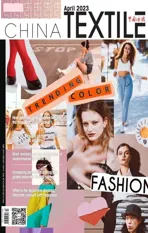What fabrics are popular with students in China?
2023-07-18ByZhaoXinhua
By Zhao Xinhua
The school uniform is not only the symbol of the campus, but also the carrier of the inheritance of the campus culture. It should not only conform to the contemporary aesthetic, but also have a strong cul—tural belonging. In recent years, the fabric and design of school uniforms have been constantly innovated.Beautiful, decent and textured school uniforms are welcomed by more and more parents and students.
The first recorded evidence of a school uniform for students dates back to a school in London in 1552. It was a charity school called Christ’s Hospi—tal that educated orphans and poor children. After this, the concept of school uniform spread quickly throughout England. In the early years of the Republic of China to the 1920s, the clothes that integrated western clothing elements and traditional Chinese clothing characteristics became the school uniform of female students. “Chinese tunic suit”, “Lenin suit”,“sailor suit”, etc. used to be the representatives of school uniforms of different eras. In the 1990s, the oversized school uniforms featuring comfort and sports style became the standard of school uniform all over the country. After entering the 21st century,although sportswear is still the mainstream, different schools choose uniforms independently according to the school style. Some Western—style uniforms and gowns appear in the school uniform set, and the requirements for school uniform fabrics are also in—creasing year by year.
Now, some parents prefer cotton uniforms. Undeniably, cotton clothing is breathable, soft, sweat absorption, but cotton is easy to wrinkle, shrink and has low elasticity, poor moisture drainage. Therefore, we see on the sewing label of the school uniform that the fiber composition in addition to cotton, also includes spandex, polyester fiber, viscose fiber and other com—ponents. Among them, spandex can increase the elasticity and wear resis—tance of fabric; polyester fiber is wrinkle resistant and has the advantage of quick drying; viscose fiber moisture absorption is good but easy to stain.


The latest biotechnology is also leading the innovation of school uni—forms. For example, the new bio—based environ—mentally friendly fabric Thylon PA56, compared with the blended fabric of traditional school uniforms, retains the active ingredients of natu—ral fibers. And it has the advantages of various traditional fabrics: tenacity of nylon 66, moisture absorption and skin affinity of cotton and silk, and perspirability of polyester. It also has features of low carbon environmental protection, strong anti—bacterial, higher color fastness.
In fact, whether wearing uniform in the world has triggered a great discussion. A study written by Chris Bauman and Hana Krskova and pub—lished in the International Journal of Educational Management found that students in uniforms are better listeners. In the International Journal of Behavioral Nutrition and Physical Activity, Nicole Nathan and a team of researchers explore the relationship between school sports uniforms and participation in physical education lessons. The study found that there was “significant reduc—tion in sedentary activity” among students who wore uniforms. The latest data from The NationalCenter for Education Statistics finds school uniforms are more popular than ever in the United States.
A study by Trutex found that 94% of UK teachers (from a sample of 180) believed that school uniforms improved the school’s image in the community. A common reason for the re—quirement to wear uniforms is that it helps identify students as belonging to the school (and helps identify intruders). 89% Of UK teachers believe school uniforms reduce bullying. 70% UK stu—dents believe school uniforms help them fit in.
The growth rate of students is fast, the replacement fre—quency of school uniforms is high, and the recycling of old school uniforms has also aroused the attention of the society. Some professional platforms provide functions such as creative pro—duction, recycling and AR fitting of old school uniforms, making the recycling of school uniforms a sustainable industry. The old uniforms can be professionally cleaned and disinfected for the younger students, or donated to schools in remote mountainous areas.
Combined with educational characteristics, aesthetic edu—cation culture into the design, in line with the school culture system and students’ growth characteristics of school uniforms,will become the development trend of school uniforms in the future.
杂志排行
China Textile的其它文章
- Is it possible to get fruits and dresses from a plant?
- The revolution of tape: stick it anywhere you want!
- How does bio-based leather become the favorite of luxury brands?
- Grains add new colors to plant dyeing
- Brief analysis on the application of nanocellulose in textile field
- Survey: Results of the 18th ITMF Global Textile Industry
